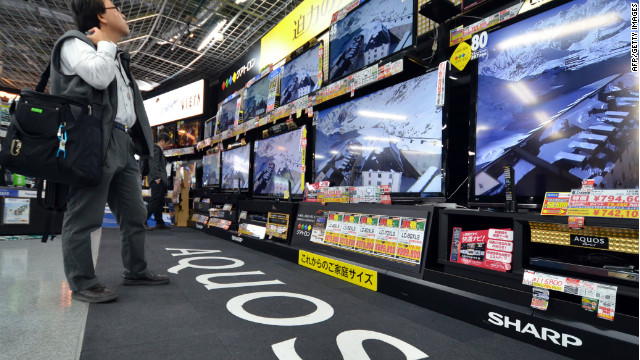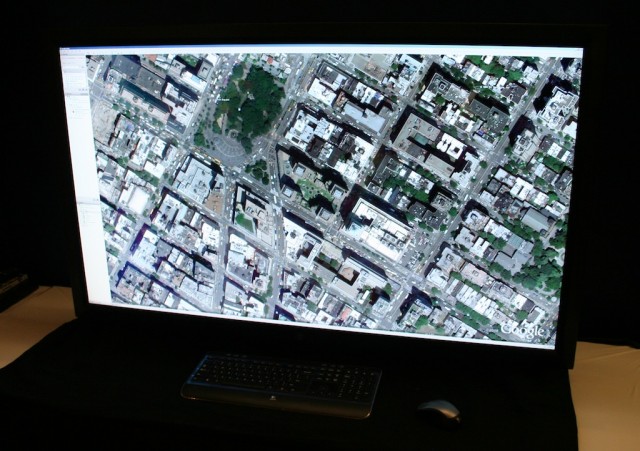Not looking good for a large competitor in the CE industry. Gives a good insight to the challenges faced by all in the Consumer Electronics Industry. They have more than most with little else to fall back on while key categories are challenged.
JZ
Hopes dim for Sharp amid Japan's TV industry sunset

A salesperson walks among Sharp Corp's Aquos liquid-crystal display (LCD)
televisions displayed at an electronic store in Tokyo in this June 8, 2012 file
photograph.
Credit: Reuters/Toru Hanai/Files
By Tim Kelly
TOKYO |
Fri Aug 3, 2012
6:56am EDT
TOKYO (Reuters) - Sharp Corp shares
tumbled nearly 30 percent to their lowest closing level since 1976 on Friday as
investors questioned whether Japan's last major maker of television panels will
survive the sunset of the country's TV industry.
A day after the century-old company warned of an operating loss of 100
billion yen ($1.28 billion) for this fiscal year, Moody's and Standard &
Poor's cut their credit ratings and rival Fitch warned that Sharp could lose
investment-grade status unless a planned restructuring succeeds.
Sharp's mounting losses, a symptom of Japanese TV makers' increasing
uncompetitiveness against rivals from
South Korea and elsewhere,
leave it scrambling for a fresh cash injection.
Analysts say its future may hinge on whether Hon Hai Precision Industries,
the flagship of Taiwan's Foxconn
"Sharp has been helped by Hon Hai, they may need more help," said Yuuki
Sakurai, CEO of Fukoku Capital Management, the asset management unit of Japan's
Fukoku Mutual Life Insurance. "Japan's TV makers are just relying on their past
legacies. As long as they depend on TV they will face tough
competition."
Revealing expectations for an operating loss this business year of 100
billion yen and announcing 5,000 job cuts, its first in six decades, the maker
of Aquos TVs on Thursday insisted it retained the backing of its main banks,
Mizuho Financial Group and Mitsubishi UFJ Financial Group.
Investors were unconvinced and dumped the stock, which slid 28 percent on
Friday to 192 yen, its lowest level in 36 years and cutting the company's market
capitalization by more than $1 billion to $2.72 billion.
SHARE COLLAPSE
Sharp, which got its start 100 years ago making mechanical ever-sharp pencils
from which it derived its name, declined to comment on the share
collapse.
Adding to Sharp's woe and handicapping its ability to raise fresh funds,
Moody's Investors Service on Friday cut the company's short-term debt rating
from Prime-2 to Prime-3, the lowest investment grade.
Moody's cited "concern that the company's operating performance and
additional restructuring costs will continue to pressure its cash flow
downwards, thereby increasing its dependence on external sources for
liquidity".
Those external sources so far include Hon Hai, which in March agreed to buy
into the ailing TV maker.
S&P's decision to cut its rating came after the Japanese company on
Thursday expanded its annual net loss forecast to 250 billion yen from 30
billion yen.
The net loss of 138 billion yen in the three months ended June 30 has already
taken a big chunk out of Sharp's capital. Its shareholders' equity ratio slumped
to 18.7 percent from 23.9 percent at the end of March, falling below the 20
percent threshold generally considered to be healthy.
"With Sharp's losses growing to this level, there's barely going to be any
net capital left," said Makoto Kikuchi, CEO of Myojo Asset Management in
Tokyo.
WANING DEMAND
Like rivals Sony Corp and Panasonic Corp, Sharp has been hammered by waning
global TV demand and aggressive overseas competitors led by Samsung Electronics
that are grabbing a bigger slice of a shrinking pie. Sony's stock fell 7 percent
on Friday to 897 yen, its lowest since 1980, while Panasonic was off 3.8
percent.
Combined, the three Japanese TV makers this business year expect to sell
around 10 million fewer TVs than they did the previous year.
While Sony has movie studios, an insurance business and a gaming unit, and
Panasonic builds batteries and automotive devices that can offset TV losses,
Sharp, which invented transistor calculators and pioneered LCD TVs, has fewer
options to retool.
Underlining a looming cash crunch, Sharp's credit default swap spreads - the
cost of insuring its debt against default - have been widening since February,
with the 5-year contract currently at an all-time high of 833.3/1000.
In the past month the CDS curve has shown a dramatic inversion, which means
it is now more expensive to buy insurance against default for shorter maturities
than longer maturities.
Such an inversion is usually seen in small, fragile companies. (for CDS
graphics, click on
r.reuters.com/sys79s and
link.reuters.com/xys79s)
"The availability and cost of credit will be affected if lenders continue to
be concerned about the company's prospects," Fitch said in a report
Friday.
Sharp's next financing hurdle is a 200 billion yen convertible bond that
matures in September next year. It was issued in October 2006 when the stock was
trading above 2,000 yen at a conversion price of 2,531 yen.
"They'll get support from the banks and get through their immediate funding
concerns... but they're going to have to do some equity financing to strengthen
their capital base," Myojo's Kikuchi said.
HON HAI HELP?
One option for Sharp could be to seek more investment from fellow Apple Inc
supplier Hon Hai.
In March it agreed to buy a 46.48 percent stake in Sharp's LCD plant in Sakai
in western
Japan. Much of the company's
losses stem from the underutilized facility.
Hon Hai also agreed to purchase new Sharp shares worth 66.9 billion yen,
giving it an 11 percent stake in the Japanese company. Hon Hai has yet to stump
up the money for that deal, in which it agreed to pay 550 yen for each new
share.
Speculation has swirled that the Taiwanese company may renegotiate given the
fall in Sharp's share price, and it said in a statement on Friday that Sharp had
agreed it did not need to honor the deal.
"Due to the volatility of Sharp Corporation's share price, Sharp Corporation
agrees our company does not need to honor the share purchase agreement signed on
March 27, but Sharp Corporation will still reserve the right for our company to
purchase the same percentage of shares," Hon Hai's statement said.
Sharp's president, Takashi Okuda, had said on Thursday that Hon Hai would
honor the deal at the agreed price.
In June, when Sharp's shares were trading above 400 yen, Hon Hai Chairman
Terry Gou told an annual general meeting the firm was in talks with Sharp about
increasing its stake. Local media later reported that Hon Hai hoped to seek a
board membership in Sharp.
Although saddle with ballooning losses, Sharp remains an attractive partner
for Hon Hai because of its research into new technologies such as next
generation ultra thin high definition screens and advanced manufacturing
processes it has honed at Sakai, the world's most advanced LCD plant.
Sharp, however, may not be easy to woo despite its ballooning losses. Okuda
told his company's shareholders at their annual gathering in June that there
would be no more capital coming from Hon Hai and that there was no plan to
invite Gou or any of his executives to join Sharp's board.
(Additional reporting by Reiji Murai,
Mari
Saito and
Dominic
Lau in Tokyo, Clare Jim in Taipei and Umesh Desai of IFR in Hong Kong;
Editing by Edmund Klamann and
Alex
Richardson)











